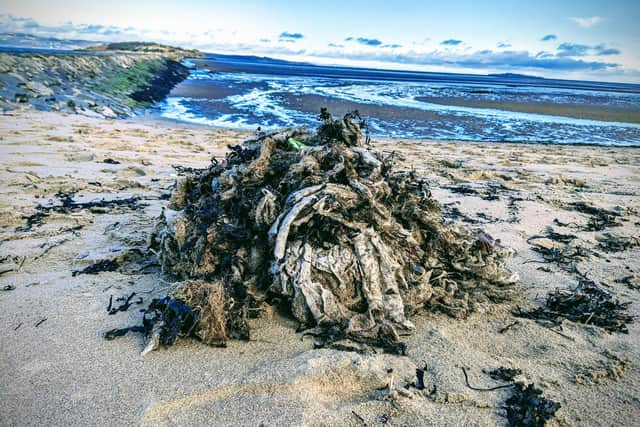Rain drain: How sewage that could fill 19,000 swimming pools was spilled in Scottish waters in 2022
Massive quantities of raw sewage being spewed into rivers and seas is causing disgust and outrage in Scotland and elsewhere around the UK.
Everything from rainwater to toilet flushings and rubbish that collects in gutters and street drains has regularly been washed into popular swimming waters and close to sensitive wildlife sites.
Advertisement
Hide AdAdvertisement
Hide AdThis untreated sewage can contain harmful chemicals, medicines, bacteria and viruses, as well as debris such as wet wipes, sanitary products, plastics and cigarette butts, raising concerns over health risks to people and the environment.
But while public outcry has prompted England privately owned water companies to announce plans for a massive clean-up, the situation in Scotland could be no better – potentially worse.
Only a small proportion of overflow points north of the borders are monitored, so there is no real way of knowing the extent of the problem here.
Official figures show there were more than 14,000 known overspills of untreated waste water across Scotland 2022, amounting to almost 40 incidents each day and a rise of around 50 per cent compared to five years earlier.
The incidents resulted in at least 47 million cubic metres of effluent being dumped into the environment – enough to fill almost 19,000 olympic-sized swimming pools – maybe more, as the volume of waste expelled was not recorded in many of the cases.


South of the border the statistics are even worse, with a total of 301,091 sewage spills recorded last year, an average of 824 a day.
The discharges come from overflow devices which are designed to release storm water and drain waste at times of extremely heavy downpours, to stop sewage backing up into homes, businesses and communities. It can also happen when pipes get blocked.
However, there has been a steady rise in the number of spill events over the past few years, meaning what was intended as an emergency protection during “extreme” wet weather has now become commonplace.
Advertisement
Hide AdAdvertisement
Hide AdAnd a lack of monitoring in Scotland – where only a tiny fraction of spills on the 31,000-mile network are automatically logged – has raised fears that the level of sewage dumping is much worse than reported.


New analysis of the figures by the Marine Conservation Society (MCS) shows just 123 of Scotland’s 3,617 storm overflows – less than four per cent – are currently monitored.
This compares poorly against England, where 91 per cent of overflows have gauges installed, and Wales, which has monitoring at almost all sites.
“All we have is a tiny snapshot of data for storm overflows in Scotland, but from what we can see they paint a terrible picture of the situation,” said Laura Foster, the charity’s head of clean seas.
“For thousands of hours each year, untreated sewage is being released straight into Scotland’s seas. This includes into designated bathing sites as well marine protected areas which have been specifically recognised for their environmental importance.”


Governments and water companies have been lambasted for their failure to get on top of the problem. Scotland’s First Minister Humza Yousaf was questioned in parliament earlier this week, with Scottish Liberal Democrat leader Alex Cole-Hamilton calling for the government to introduce legally binding targets to tackle sewage dumps.
“Look at what we’ve discovered in the last few weeks,” he said. “Human waste dumped around best loved beaches, wetlands of international importance and special protection areas, from Shetland to the Clyde.”
He also criticised Scotland’s lack of data. “In England every single pipe is due to be monitored by the end of this year,” he said. “When will we catch up?”
Advertisement
Hide AdAdvertisement
Hide AdMeanwhile, demonstrators have descended on seasides and rivers across the country this weekend to call for action on sewage pollution, including a paddle-out protest at Edinburgh’s Portobello beach yesterday.
Henry Swithinbank is policy and research manager for Surfers Against Sewage, which organised the demos. “In 2022, Scottish Water discharged untreated sewage into Scottish rivers, lochs and seas at least 14,008 times,” he said.
“Not only is this putting water users who swim, surf and paddle at risk of illnesses like gastroenteritis, it’s also destroying world-famous sites of natural beauty which thousands of locals and tourists flock to every year.
“What’s worse is that this figure is likely to be a massive underestimate.”
So why are things so bad – and getting worse?
According to Scottish Water, the publicly owned company responsible for drinking water, treatment plants and the sewer network across Scotland, the problem stems from a combination of factors.
The first is climate change, which is bringing more frequent “extreme” rainfall episodes. The increase in water coming out of the sky is simply overwhelming drainage systems.
The second is the changed nature of our cities, with more people meaning a greater proportion of roofs, roads, concrete and tarmac replacing green space.
And third is the age of our sewerage system, with much of it built in the Victorian era.
Advertisement
Hide AdAdvertisement
Hide Ad“In many ways the sewer network is still a marvel of engineering but our towns and cities have grown since they were installed and waste water systems that were built for relatively small towns are now being asked to take the rainwater and sewage for today’s population,” says Professor Simon Parsons, director of strategic customer service planning for the company.
“Overflows that spill are needed so that water doesn’t back up,” he explains. “The system has always spilled to prevent flooding of people’s homes and that is now happening more often.
“Our waste water networks and infrastructure weren’t designed to cope with anything like the amount of water that is now being thrown at them.
“Every monoblocked driveway is only adding to the problem. Rainwater simply runs off these surfaces into the drains, whereas the same water used to soak away in green spaces.”
Scotland land: 'Secret sales' and wealthy corporations make up most Scottish land sales, study finds
Physical evidence
Last year MCS beach clean-ups removed more than 35,000 sewage-related items from Scottish shorelines. Some regions in the central belt were particularly dirty, with as many as 374 items collected on every 100m stretch. And that’s despite some overflows – about two in five – being fitted with screens to prevent the escape of bigger items.
“We know sewage dumping in Scotland is bad by the amount of sewage-related litter that our volunteers find on beaches in certain areas across Scotland,” says Catherine Gemmell, Scotland conservation officer for the MCS. “But we still don’t know quite how bad it is, given that only 3.4 per cent of sewage overflows are monitored.”
So why are sewage spills still happening?
Prof Parsons added: “Even if it was possible to stop all spills – which it isn’t – that would only lead to a potentially greater set of problems, with huge numbers of homes and communities flooded.”
Advertisement
Hide AdAdvertisement
Hide AdThe current drainage and waste water system has been more than 150 years in the making and cannot be replaced, he says. “A new system that would allow us to separate all rain water from all sewage would take decades to achieve, would cause levels of disruption that people would never accept and would cost upwards of £13 billion. It is simply not possible.”
Water companies in England, where sewers and supplies are privately owned, have apologised for the amount of contaminated water spilled and promised to spend £10 billion on upgrading the network.
Scottish Water set out its Improving Urban Waters Routemap at the end of 2021, outlining steps to improve management of sewer systems – including investment of up to £500 million to deliver improvements in water quality, spill monitoring and provision of public information.
Efforts will focus on areas where the system isn’t working as it should or could perform better, on a prioritised basis – based on the impact or level of spills, with the highest urgency for the likes of bathing waters or shellfish areas.
“We accept that visible debris, including wet wipes and sanitary products in rivers, is not acceptable and we are determined to tackle those locations where that is an issue,” Parsons said.
But Surfers Against Sewage campaigners say urgent action is required in order to tackle contamination.
“Scottish Water are only required to monitor and report discharges from under four per cent of Scottish overflows and many of those are only monitored during the summer.
“That means we have no idea what’s coming out of the other 96 per cent of pipes.
Advertisement
Hide AdAdvertisement
Hide Ad“Whilst on paper Scotland’s numbers are better than the horrendous figures we see in England, namely 301,091 spills a year, the honest truth is that we’re in the dark on just how much pollution is being pumped out by Scottish Water.
“The public are sick of pollution being swept under the rug. The Scottish Government have the power to make sure Scottish Water reveal the true extent of pollution – they must use it."
According to Scotland’s environmental regulator, which has powers to punish offenders if standards are breached, the country’s water quality is currently at its highest levels ever, with 87 per cent of water bodies rated good or better and a record number of bathing waters – 38 out of 87 designated sites – graded ‘excellent’.
The Scottish Environment Protection Agency (Sepa) publishes water quality test results during the official bathing season – June 1 to September 15.
Nathan Critchlow-Watton, head of water and planning for the agency, welcomed the increased public interest in the state of our seas and rivers but warned that it was important to recognise the “huge national undertaking” required to upgrade the system.
“It means focusing effort where it will have the biggest impact,” he says, “prioritising investment where it will most benefit our environment and communities.”
He said the regulators would ensure commitments, including targets to install monitors on every combined sewage outflow discharging to a bathing or shellfish water by the end of 2024, would be delivered.
“While Scotland already enjoys some of the best water quality in Europe, Sepa is focused on ensuring improvement continues in the years ahead,” he said. “We’ll do that by working together with public partners and regulated businesses, using our enforcement powers when necessary.”
Advertisement
Hide AdAdvertisement
Hide AdSo what’s the outlook – will we have to suffer more pollution before the situation can be improved?
Prof Parsons said: “Unfortunately, rainwater flooding and waste water spills are a fact of life and they are going to increase as climate change not only continues but accelerates. We’ve been talking about climate adaptation for a long time it seems, but this is the reality of it.
“We cannot engineer or invest our way out of climate change impacts. We must adapt to them, with things like increasing the amount of green spaces that can hold back rainwater from entering the underground system.”
Work is already under way to increase monitoring levels at some of the worst offending overflows. However, some graded ‘high priority’ – if they spill in dry weather; cause failures in water quality standards; dump high quantities of sewage litter; or environmental complaints or incidents have been recorded – may not be upgraded until 2027 or even 2031.
“Flooding and spills are one of the front lines of climate change here in Scotland and any assumption that our water company can fix it is misplaced,” Parsons says. “It can’t be fixed by Scottish Water alone – bigger and bigger pipes will never keep pace with increasing rainfall.
“We are trying our hardest to protect homes and communities, as well as the environment, but we can’t hold back the rain.”
And everybody has a role to play, Parson insists, firstly in understanding the realities of what we face and then by supporting radical changes in the way we live. This includes reducing the quantities of water being poured down drains, not flushing stuff down toilets that could block pipes or end up as litter, and considering the impact of buildings and developments.
“What we cannot do is remove all the rainwater that is currently going into the system,” he says. “For that we are going to require a radical redesign of our towns and cities, create far more spaces that can soak up or hold back rainwater to prevent the waste water system overflowing. There are some brilliant examples in other countries of this being done but enormous public and political will would be needed to do that in Scotland.”
Comments
Want to join the conversation? Please or to comment on this article.